
The new-for-2016 Mossberg Modern Rifle (MMR) is a thoughtful combination of the best features and performance possible at a reasonable price. Image courtesy of manufacturer.
For more information, visit https://www.mossberg.com/.
To purchase on GunsAmerica.com, click this link: https://www.gunsamerica.com/Search.aspx?T=MMR.
Mossberg has long been known for providing value-priced firearms that get the job done. In fact, my first real gun was a Mossberg 20 gauge shotgun that has taken many birds and deer. It was a no-frills field gun, but it never let me down.
Mossberg starting selling their first AR-15 rifles in 2011. The original MMRs were true to the Mossberg roots—solid rifles at attractive price points. They included the MMR Hunter series and MMR Tactical series rifles. For 2016, Mossberg decided it was time to update the MMR and in doing so, they’ve taken it to a new level. The older versions of the MMRs are no longer available as Mossberg rolls out the updated models of the MMRs.
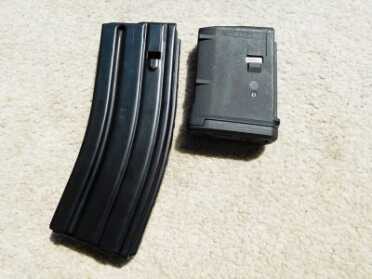
A 30-round metal magazine comes with the gun. This Magpul 10-rounder also worked well as did a Bushmaster mag.
SPECS
- Chambering: 5.56 NATO/.223 Rem.
- Barrel: 16-25 inches
- OA Length: 35.75 inches
- Weight: 6.75 pounds
- Stock: Six-position collapsible
- Sights: Post front, adjustable rear
- Action: Direct gas impingement
- Finish: Phosphate/anodized
- Capacity: 30+1
- MSRP: $910
The first new MMR is a basic model intended as an all-around carbine. Although basic, each component was carefully considered. The most obvious change is the slim new 13-inch aluminum handguard that wraps around the free-floating, A2-profile barrel. It’s also a good example of the thought process that went into building this gun.
The previous MMR wore a quad rail forend. Picatinny rails are great for mounting accessories, however, when you get a bunch of accessories attached to the handguard, it starts to get bulky. The sharp-edged rails can also be hard on the hands. In 2007 Magpul developed their first slot system to address this. They called it their MOE mounting system and it allowed attaching accessories directly to the handguard without the need for a rail. However, there was a drawback in that you needed to access the back of the handguard to install accessories.
Then in 2012, VLTOR and Noveske teamed up to develop Keymod. With the Keymod system, you could attach your accessories without the need to have access to the back of the handguard. Keymod use has been growing in popularity, but Magpul wasn’t about to leave it at that.
The new Magpul standard is called M-Lok, which stands for Modular Lock system. The slots are a little bigger than the MOE system and it’s no longer necessary to access the back of the handguard. The accessories are held in place by cammed T-nuts. This makes installation of M-Lok parts as easy as the Keymod system with added benefits. Due to the way Keymod functions, you can only install accessories one way. You have to go from the wide end of the slot to the narrow end. M-Lok accessories can be installed either way, giving you added positions for spacing. They also incorporate recoil lugs making the M-Lok mounts more resistant to shifting under recoil.
Answering The Why

M-Lok accessories can be mounted facing in either direction and are held fast by a combination of cammed T-Nut and recoil lugs which extend into the slots. Image courtesy of manufacturer.
When I asked the folks at Mossberg about their thinking in going with the M-Lok system, this is what they told me:
- Magpul/M-Lok market share is stronger
- Direct attachment—Customer does not have to use aluminum rail mounts
- Direct mount capability—No access to back side of rail required
- Four-axis recoil-mitigation lugs—At every increment, accessories are supported by lugs on all four sides
- Adjusts evenly in 1/2 slot increments for precise accessory placement
- Multi-directional Mounting—Accessories can mount with either end facing forward
- #10 mounting screw—For greater strength and fewer stripped screw heads
- Optimized for both metal and polymer—Easy to manufacture, plus stronger and more secure
- Custom, self-aligning T-nut—Strong, inexpensive, and easy to use
So you can see they didn’t just stick it on because it looks good, although it does. They methodically identified what would be best for their customers in the long run. Which attachment system will have the most products, which system is superior in everyday use, which system is more versatile? That’s the philosophy I see reflected in the entire gun.
Intelligent Options
There’s a full-length rail mounted on top for sights. The supplied iron sights are target adjustable and the longer top of the handguard provides added sight radius.
The A2 profile barrel with mid-length gas tube is a good all-around barrel. It’s also ramped for more reliable feeding. The gas system is direct impingement for simplicity and reliability, and the barrel is free floated for accuracy. While the earlier MMR had 1:9 rifling, the updated MMR has 1:8 to stabilize the heavier bullets gaining popularity. In the range report you’ll see that this rifle really likes the Hornady 75-grain boat tail hollow points (BTHP).
The trigger has a typical mil-spec weight of 7 pounds, but is free of creep and is not at all gritty. That’s not typical. It provides a nice clean break with the reliability and safety factors afforded by a mil-spec trigger. I prefer a lighter trigger, but there are options available in the aftermarket if a little polishing doesn’t get you where you want to be.
The stock is a UTG Pro six-position adjustable unit that provides the best fit regardless of what you’re wearing, from a summer T-shirt to a winter parka. The Magpul trigger guard is curved to provide more room for gloved fingers.
All-in-all, the build quality is excellent. The upper and lower fit together as well as any mass-produced AR you’ll find. They’ll also interchange with other AR-pattern rifles. The steel surfaces are phosphate coated and the aluminum is anodized. If you’re not familiar with phosphate coating, commonly called Parkerizing (although that is actually a proprietary name which has come into common usage much like Kleenex), it’s a method for providing corrosion resistance that’s been in use by our military for decades. It provides more corrosion protection than bluing and also adds lubricity and anti-spalling properties.
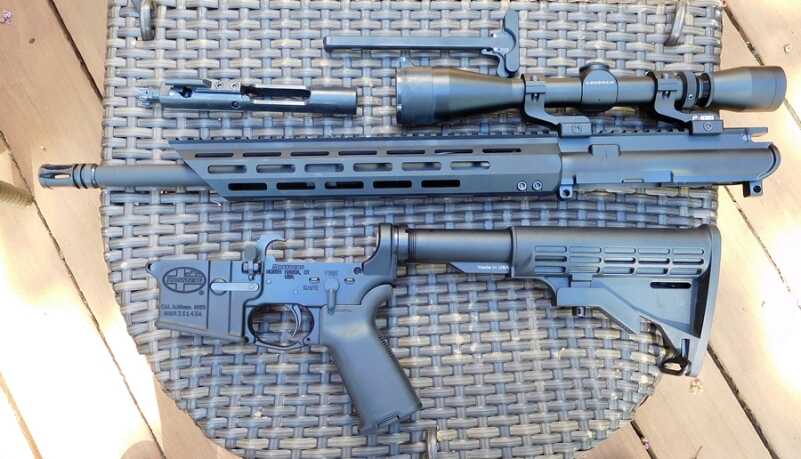
The MMR is at its heart an improved AR. It takes all the strengths of the basic design and adds thoughtful upgrades and enhancements.
The bolt is made from Carpenter 158 steel, which is what Eugene Stoner specified in his original design to withstand the stresses on the locking lugs and the area of the bolt where the cam pin hole is found. Some other lower-price ARs use 8620 steel because it’s cheaper, although not as strong. Mossberg stayed with Stoner’s specs for longer bolt life. The bolt also gets phosphate coating.
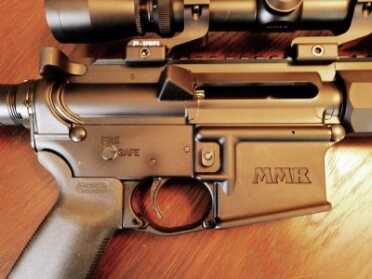
Mossberg eliminated the forward assist and dustcover. It makes the MMR a little easier to maintain and less expensive to produce. Note the enlarged Magpul trigger guard.
ARs with 16-inch barrels generally utilize carbine length gas tubes or the newer mid-length tubes. The mid-length tubes run at lower pressures at the port which means less stress on internal parts and longer life/dependability. Mossberg went with the mid-length gas tube.
The included Magpul pistol grip is comfortable and well-positioned for extended shooting. It also doesn’t get sticky or oily in the heat like some rubber grips do. A storage compartment affords a handy place to keep backup batteries for your optic.
The birdcage flash suppressor is typical AR and, with slots only in the top, offers some compensation to offset muzzle rise. The most atypical features are the lack of a forward assist and dust cover. In both cases, I believe it’s a better gun without them. The forward assist is something that most people will never use in a sporting rifle. The dustcover is a maintenance item and is flimsy enough that it could easily be bent. They are both items I would gladly eliminate to get to the price point Mossberg has set for this gun.
MSRP is $910.00. That’s $10 less than the price of the gun it replaces, the old style MMR. You’ll find street prices to be significantly less.
Range Performance
The MMR is an easy gun to shoot, as are most ARs. It’s light with modest recoil and the top rail provides a sturdy mount for optics. For accuracy at 100 yards, I fired from a bench resting the gun on a wooden block. The first day at the range I used a Caldwell Lead Sled. The second day when I got to the range, 80 miles from my house, I realized the Lead Sled wasn’t in my truck. Oops. So I fired anyway. I figured you won’t be shooting from a Lead sled when you’re drawing down on that trophy jackalope.
I’m just an average shot, so the figures listed here aren’t a thorough test of each brand of ammo. But it’s obvious that this is a better than 1 MOA gun. My three best groups were 0.935, 0.805 and 0.771 inches. It’s nice to see that Mossberg still delivers.
[one_half]
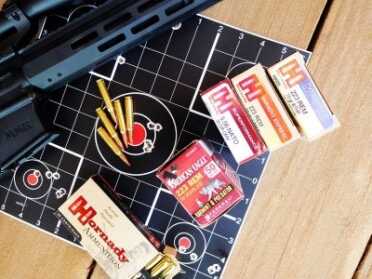
The ammo was graciously provided by Federal and Hornady. It worked great and is capable of much better groups than this average shooter can manage.
[/one_half]
[one_half_last]
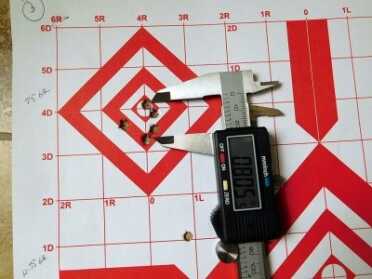
The Hornady .223 Rem 75-grain BTHP load performed extremely well in the MMR. This is a great round for reaching out.
[/one_half_last]
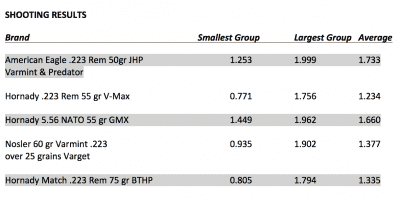 The MMR is chambered for 5.56 NATO so it will shoot both 5.56 and .223 Remington ammo. The ammo used for evaluation ranged in price from less than fifty cents a round for the American Eagle to more than a dollar a round for the Hornady 75-grain load. Sighting-in was accomplished with the American Eagle 50-grain JHP Varmint and Predator ammunition from Federal. That was the lightest load tested. I then ran through the various cartridges increasing bullet weight till I got to the Hornady .223 Rem 75-grain BTHP.
The MMR is chambered for 5.56 NATO so it will shoot both 5.56 and .223 Remington ammo. The ammo used for evaluation ranged in price from less than fifty cents a round for the American Eagle to more than a dollar a round for the Hornady 75-grain load. Sighting-in was accomplished with the American Eagle 50-grain JHP Varmint and Predator ammunition from Federal. That was the lightest load tested. I then ran through the various cartridges increasing bullet weight till I got to the Hornady .223 Rem 75-grain BTHP.
Like most guns, the MMR showed a preference for some loads. My best groups were with the Hornady .223 Rem 55-grain V-Max, the Hornady .223 Rem 75-grain BTHP Match and a .223 handload using a 60-grain Nosler Varmint over 25 grains of Hodgdon Varget. However, all brands grouped into 1½ inch or less, which is excellent. We aren’t just in the golden age of guns today, we’re in the golden age of ammunition too. New shooters will take the consistency we’re seeing from the ammo manufacturers for granted, but if you’ve been around for a while, you know how much better ammo is today.
As I said earlier, Mossberg has discontinued production of the earlier MMR models although you can still find some for sale. But when that inventory is gone, there won’t be anymore. Which is okay with me since the updated model provides even more value. Did I mention that it’s $10 less than the original MMR with iron sights!
Mossberg will continue to introduce more models and calibers of MMR through 2017. In the meantime, if you’re in the market for a solid performing basic AR-15 for hunting, competition or home defense, I highly recommend the new Mossberg MMR. It’s a quality gun at a great price point, and from an American company that’s been around since 1919.
For more information, visit https://www.mossberg.com/.
To purchase on GunsAmerica.com, click this link: https://www.gunsamerica.com/Search.aspx?T=MMR.

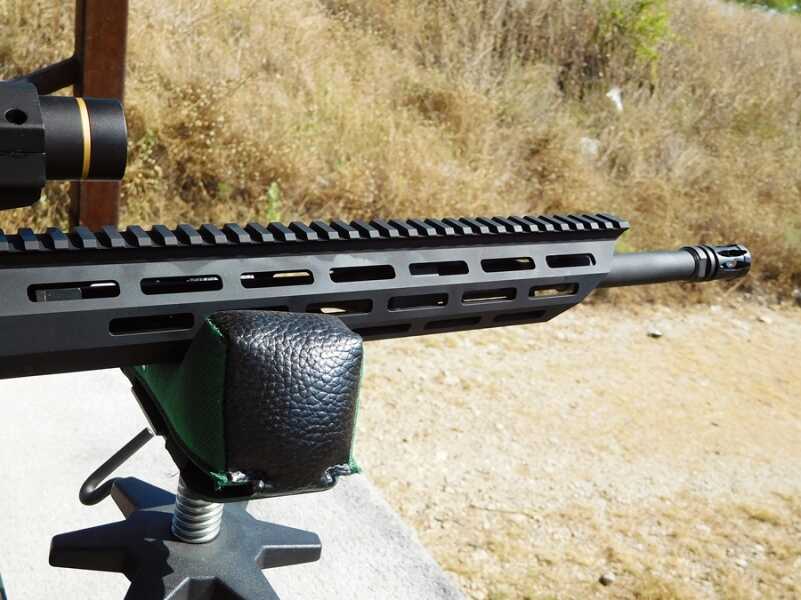

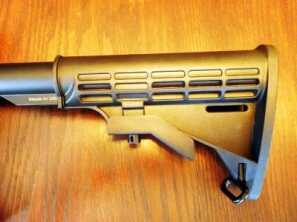
BEWARE of 1:9 twist barrels!
I got the 2016 MMR from Academy last week (only place I could find it). It’s $700 on special now. Brought it home and put it under my shop light to examine more closely and was shocked to see the barrel stamped with “5.56mm NATO 1/9″ — NOT 1:8 as advertised by Mossberg or described in any of the reviews. I shoot NRA high-power through a match rifle with a 20” 1:7, so almost all my ammo is loaded with 77gr. berger bullets, (some is store-bought 69gr and 75gr). The MMR with the Free Float 1:8 barrel looks almost perfect for other kinds of matches like 3 gun and for introducing friends and family to the sport. But a 1:9 twist just won’t cut it.
So before you pick up your MMR from your LGS, check the small stamp on the barrel to make sure its not one of the ones with the 1:9 (all the other MMR’s on the shelf at Academy also had 1:9).
Academy wouldn’t take the MMR back so the next day I fedex’d it to Mossberg. They’re supposed to make it right. And the day after I sent it to Mossberg, a manager from Academy called me and said they actually would take it back (a day late, dollar short!)
Really looking forward to shooting this gun. It looks like the MMR (with the right barrel) is a better package than the new SA SAINT that was just reviewed which does not have a free-float barrel (which is more important to me than having the dust cover and forward assist). It would be awesome to see a side-by-side comparison.
When I get the MMR back, I will hopefully have lots of reasons to give glowing reviews of not only the rifle’s performance, but also of Mossberg’s customer service.
I was told by mossberg csr that barrel does have 1.8 twist but was stamped in correctly. Was curious to see what you were told & if you could give some feedback on this rifle. I was looking into purchasing one but wanted an honest opinion from someone who actually owns on .
I got the MMR back from Mossberg–with the correct 1:8 barrel installed. There was nothing extra in the box other than a sheet that listed the parts used, including 20 rounds of a field test load. The rifle did not appear to be cleaned after they ran a box of ammo through it. I took it to the local indoor range (only 25 yard–couldn’t break away from work to make it to the 200 yard outdoor range yet). I shot 100 rounds of “cheap” 55gr. Remington with the included iron sights and got it dialed in fairly well, but I was mostly focusing on how reliably it functioned, including testing 5 different brands of mags.
Good News: Not 1 function failure. Reasonably accurate from benchrest using 55gr ammo, iron sights (and poor lighting in the range). Comfortable M-Lok handguard. OK iron sights (FYI: exactly 20 clicks up on elevation at 25 yards).
Bad-ish News: When I moved up to the ammo I intend to shoot more regularly, the 77gr HPBT stuff that is at least a buck-a-bullet (unless I’m using my match reloads), my grouping from benchrest blew out to 2″ at 25 yards. Terrible. But, a) that will probably improve after I clean it, and b) maybe 77gr is outside the limits of this 1:8. Hopefully the groups will be MUCH better when I try some 69gr HPBT.
Summary: Reliability is promising (though I can’t say a rifle with only a couple hundred rounds is truly proven reliable). I like how the MMR “feels” with regard to balance and left hand on the M-Lok handguard. But I’m not impressed with either accuracy (yet) or Mossberg. Compared to Windham Weaponry, when I had to send an AR10 lower back to them to fix something, WW service apologized for the inconvenience and offered me a t-shirt–“I don’t need another t-shirt, but thanks anyway.” Well WW not only sent a cool T-shirt, but a hat–and most importantly followed up to make sure I was happy with my rifle. Contrast that to Mossberg who sounded irritated that I would expect the MMR to be as advertised, then sent me back a dirty rifle, and no followup. But ultimately, what counts most is that the rifle works–so far I’m just Ok with it, and hoping that I’ll eventually be able to give a rave review like the one in this article.
I think its very poor they sent the thing back to you dirty – it would of taken them what 10 minutes to clean the thing up a lil bit…these companies are just disgraceful.
“dustcover is a maintenance item and is flimsy enough that it could easily be bent”
I was in the army for a long time and never saw a Pvt bend a dust cover. Its one item I’d want to see on the rifle or something like the shield Ruger uses.
The forward assist is a relic from the early days of the M-16 and the dirty ammo the gov’t decided to buy and no longer needs to be on the rifles but no one except Mossberg is whiling to pay the cost for new upper s without a FA .
Getting rid of the picatinny rails is great. As you stated they are hard on the hands and add weight to the rifle. And having them so far back on the handguard is silly for most people. The 1:8 twist is great and gives more flexibility of ammo use.
All that said I think they are probably asking a little to much for the rifle. But with the current problems I think they should have introduced it 6 months ago.
Forward assist on an AR-type rifle’s something I’d rather have and not need, then need and not have. Especially if I’m operating in dirt, sand or much dust.
“sub-MOA” because of the occasional sub-MOA group? No. Not an accurate statement. If you average the group size based on the results of your table, you’ll get 1.468″. So, a 1.5 MOA rifle, using the ammo you did. Heck, I had a Valmet M76 that occasionally could put 5 shots in less than 1″ using iron sights in my (apparently steady) hands. That did not mean said rifle was “sub-MOA” accurate. But it was one heckuva version (maybe the best ever) of the AK.
I own this rifle and I can tell you that with a good optic this is definitely a sub moa rifle at most engagement ranges but do to the nature of a 5.56 round you wont see that once you get past flat trajectory , and that’s an issue with the weight of the round not the rifle imo.
AISI 4140 carbon alloy steel.
Send email alerts on this gun
I sold my MMR after one year because I couldn’t find any info concerning the barrel material other than ” low Carbon steel “. I see that the new model also leaves us in the dark concerning this issue. One has to wonder just what is Mossberg hiding here ???
Mossberg AR Barrels are made with AISI 4140 Carbon Alloy Steel. Not trying to hide anything.
I don’t mean to rain on your parade, but let’s get things right. The correct nomenclature for the Mossberg AR barrel steels is: AISI 4140 Low Alloy Steel. The AISI carbon steel series all begin with a “1”.